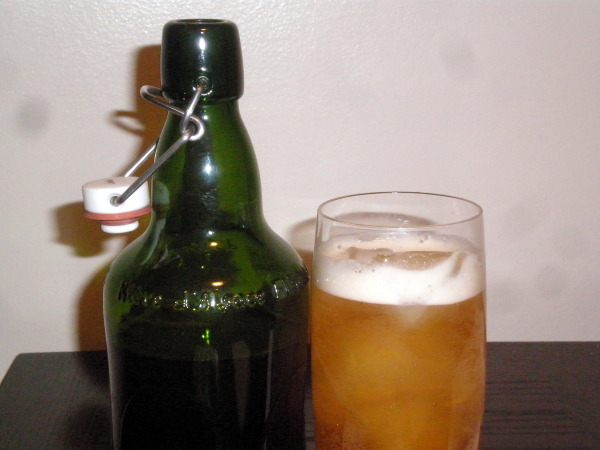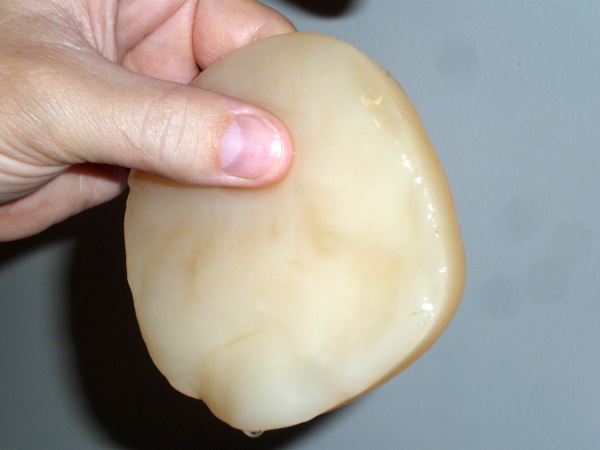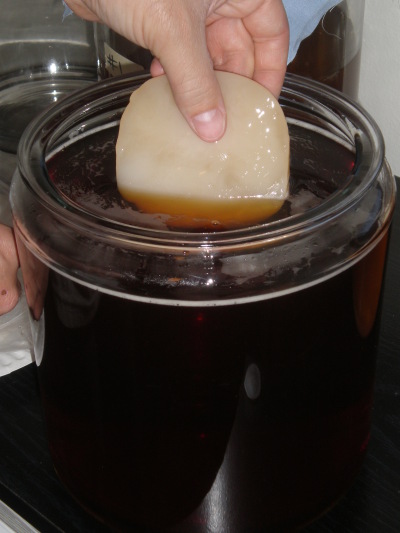Since my earlier attempt at making Kombucha from scratch was a total failure, I ordered a scoby online. This makes sense to me because virtually all things fermented are started with leftovers from the last batch; think sourdough, brewers yeast, and vinegar. From generation to generation, these "starters" were passed on. The exception being Lambic, which is traditionally allowed spontaneous fermentation, but that's another story...
What arrived was a 1 inch thick gelatinous mass called a scoby (symbiotic culture of bacteria and yeast). It may have cost me $10 after shipping and handling. I brewed up a gallon of tea with 7 Lipton Original tea bags and a cup of sugar. I waited for it to cool to room temperature so that the heat does not harm the scoby, and I dropped it into a 1 gallon glass jar.
I covered it with some cloth (or you could also use a coffee filter) and secured it well with a rubberband. Within a few days, a new, much thinner scoby began to form on the surface. After about two weeks I used a straw to push aside the new scoby and tasted it like a bartender, capping the straw with my finger.
Once it was ready I strained it into a pitcher. With the pitcher it was easier able to pour into sanitized stopper-top beer bottles using a funnel . If you like your kombucha sweeter, don't let it ferment as long - the longer you let it go, the more sugar is converted into acetic acid (vinegar).
I used the stopper-tops because they are less likely to explode if too much pressure builds inside (see the bottle above, like the brands Grolsch or Fischer). With a standard bottle cap, supposedly this can occur, or the caps shoot off making kombucha geysers in your cabinet.
Another week in the bottle allows the kombucha to carbonate itself naturally (like Krausening beer). The result is a slightly sweet and tangy carbonated iced tea. There is nothing similar to compare it too, kombucha really is in a category of its own.
In my second batch, I experimented by adding the juice of a large ginger root. I shreded the whole root with a microplane (there's no need to even peel it), picked it up with a clean hand and squeezed the juice out. Holy schniekies, this is the way to go! Granted, I'm a ginger-freak who never leaves any left at the sushi bar, but this is an invigorating drink. Ginger kombucha comes HIGHLY RECOMMENDED.
I'm going to try upping the sugar this next round in order to make something even more tart. I'm going to add more tea as well. The current recipe is very good and quite refreshing, but I desire something with a little more umph. I'm also going to experiment with different additions, herbs, spices, etc. in the coming weeks. Maybe mint next!
Making Kombucha from a purchased scoby is incredibly easy - just keep everything sterile. I use an industrial strength, iodine-based sanitizer, but you could also use a diluted bleach solution. Before you begin, I suggest that you read the following websites very carefully - and take notes:
Kombucha and Vinegar Making - by Dominic N Anfiteatro
Making Kombucha Mushroom Tea - by The Happy Herbalist
How to Make Kombucha - by Seeds of Health



